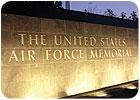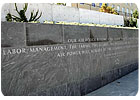
Before the U.S. Air Force Memorial was dedicated in Alexandria, VA, in October of 2006, the Air Force was the only branch of service without any Memorial in the Washington, DC, area. Now that it has been completed, the Memorial can be appreciated through the region, due to its 270-foot-high steel spires that appear to be soaring in to the air. And while the spires are the most noticeable aspect of the project from a distance, the Memorial is also a showcase of three-dimensional stonework - with Jet Mist and Absolute Black granite being used for a variety of applications.
“The United States Air Force Memorial will honor the millions of patriotic men and women who have distinguished themselves in the United States Air Force and its predecessor organizations,” according to the Air Force Memorial Foundation. “Some 54,000 airmen have been killed in action while serving in the Air Force and its predecessor organizations.”
The Memorial is located at a promontory in Alexandria that overlooks the Pentagon, the Potomac River and all of Washington, DC, and it was constructed at a cost of over $30 million.
The architect for the Memorial was world-renowned James Ingo Freed of Pei Cobb Freed and Partners, who passed away during construction of the project.
A 2004 design statement by the architect reads, in part, as follows:
The Air Force Memorial is rooted in the necessary symbolic transition of making the medium of the Air Force visible. The Navy has the medium of water, which can always be shown in fountains, and the Army has the medium of land, which can be referenced with mountains and plains; the Air Force has the medium of air, which is very difficult to show. The core of this effort lies in making air tangible, making technology felt. But, before the Memorial could take shape, the critical component, the site, had to be analyzed for its informational and formational impact.
The Memorial itself is 270 feet high and appears to be soaring; its array of arcs against the sky evokes a modern image of flight by jet and space vehicles. At the same time, it enshrines the past in permanent remembrance of the pioneers of flight who came before, and pays homage to those of the future.
Once the decision was made to have vertical elements, the number three became important, three being resonant with significant associations for the Air Force, including the three core values of today: Integrity first, Service before self, and Excellence in all we do. It is also the smallest number of elements needed to define and enclose a space. The spires are asymmetrical, dynamic, each a different height so that the view of the Memorial changes from every angle.
A path parallel to the western edge of the site, paved in Bluestone, joins two events, its southern and northern ends, creating the necessary poles for experiencing the total Memorial.
At the entrance from the west stands the Honor Guard, symbolizing patriotism and power. From here, the Bluestone path moves north to the Glass Contemplation Wall, a glazed independent panel with meditative inscriptions. It symbolizes the presence of all of those who are gone. Halfway on the journey back and forth, one finds the heart of the Memorial, a triangular prow bounded by the three spires. Standing within the soaring forms, one can see the Washington Monument. A stepped stone plinth runs parallel with the pathway and can act as seating for special events as well as for the “trooping of the colors.”

Stone highlights
At ground level, the main features of the Memorial include two inscription walls located at each end of a central lawn/parade ground area. These walls are 56 feet in length, 10 feet in height and 1 foot thick. They were constructed using monolithic Jet Mist granite and include 2 ½ -inch thick outer inscription panels made from Absolute Black granite.The South Wall honors Air Force values and campaign accomplishments (including those of the Air Force’s predecessor organizations), while the North Wall honors the “valor and sacrifices made by so many Airmen,” according to the Air Force Memorial Foundation.
The Jet Mist granite was quarried in nearby Culpeper, VA, at a site owned by Granites of America of Esmond, RI. Meanwhile, the Absolute Black granite used on the outer inscription panels was sourced from Africa and supplied through M+Q of Marina di Massa, Italy. The Air Force Memorial Foundation described this material as “the purest black granite found on earth.”
The three-dimensional stonework for the project was fabricated by A. Lacroix et Fils Granit Ltée of Saint-Sébastien, Québec, Canada, which has a long history of processing granite for high-profile, complex projects.
According to Fréderic Lacroix, secretary-treasurer of A. Lacroix et Fils Granit Ltée, the stonework on the project ranged from tiles measuring 2 feet x 2 feet x 2 inches to massive pieces measuring 12 ½ feet x 7 feet x 12 inches in size. In all, Lacroix processed 59,000 square feet of granite - including stone used for the walls and paving as well as three-dimensional monuments.
“The most complicated aspect of this project was that we had to work with very large pieces, and we had to modify a lot of our standard equipment to produce some pieces,” explained Lacroix.
The size of the pieces used was also an issue in producing the surface finish that was specified for some of the stone pieces. “We also had to purchase and modify a manual high-pressure pump in order to be able to apply the waterjet finish on some very big pieces that were impossible to fit inside the automatic waterblasting machine,” Lacroix said. “ We also had to convert our 7-axis robot CNC machine into a polishing machine in order to polish the very large triangular monuments of the project. This was quite a challenge for our engineering staff.”
In addition to modifying its machinery, Lacroix also had to devise handling methods that would accommodate the large stone pieces. “We also had to develop some techniques to manipulate those big pieces without risking to damage the edges,” he said. “When you have to manipulate 8- to 10-ton finished pieces, the effort on the edges is fairly large - especially when the piece width is very large. So we had to develop some special slings and brackets in order to increase the surface of contact of the sling on the edges in order to reduce the risk of chipping the edges. There were plenty of challenges to complete this job, even if the pieces were fairly simple, it was the size of the pieces that made the project complicated.”
In the end, Lacroix reported that its work on the project was very well received by the installer, Lorton Contracting Co. of Springfield, VA, and the general contractor, Centex Construction, LLC, which is based in Dallas, TX. “The installer and general contractor were very satisfied with our work and our professionalism in accomplishing some very hard-to-produce pieces in a fairly tight schedule,” he said.
“It was a great opportunity to work with Lorton Contracting,” added Claude Lacroix. “They had a great team coordinating on the project, and they really did a great job.”

Stone engraving and sandblasting
After the stone was fabricated, the lettering of the walls and memorial panels - as well as the engraving of other decorative features - had to be executed. This task was handled by Marcel Mächler, Inc. of Twin Peaks, CA, who worked at the site in Arlington, carefully coordinating with Lorton’s installers that were in place.According to Mächler, the Jet Mist was engraved with a range of general quotes, while the Absolute Black granite panels were used to highlight Air Force Medal of Honor recipients and theaters of battle where the Air Force played an important role. “The Jet Mist is a very nice material,” he said. “I really liked carving it. It was very homogenous, and the fine grain of the material worked well.”
Mächler explained that due to the unyielding deadline for the project, he was on site for three months, working from 6 a.m. to 6 p.m. “I am a small business, so I focused on the carving, and the sandblasting was subcontracted to a local associate. All of the letters smaller than 2 inches were sandblasted, and large ones were carved.” He added that most of the smaller, sandblasted letters, were used on the outer Absolute Black inscription panels.
The entry letters were 12 inches in height, while those on the dedication wall were 5 ¼ inches. “All of the letters were carved in a V-groove for added elegance and greater shadowing effect,” Mächler said. “There was no infill, as they wanted it very natural - no gold leaf.”
Mächler worked using air guns and carbide-tipped air chisels. “It is my style not to use Italian-type air guns,” he said. “What I use is more pistol shaped, and you can push from the back and regulate the amount of air coming out, and how hard it would come out. Some areas needed more force than others.”
At times, the size of the memorial required Mächler to work on scaffolding. “You have to be more cautious not to fall off; you can’t just kneel down as if you were working on the floor,” he said. “Also, working under a tarp with the mask and goggles, you dealt with a lot of heat at the south-facing entry during the summer.”
In addition to the letters, Mächler was also responsible for carving several Air Force logos, including the Medal of Honor. “That was a very challenging aspect of the project,” he said. “That had a very high amount of detail in granite. And overall, it was a high-profile project.”
Shortly before the dedication of the Memorial, Mächler was also asked to work on a pentagon-shaped dedication stone, which was also sandblasted by Randy Montomery Stone Engraving of Monrovia, CA. A dedication to James Ingo Freed was also carved into the stonework, citing the architect’s “gift of creativity.”
Mächler’s work on the Memorial will continue later this year, as he was asked to add a quote that was made by President George W. Bush during the dedication ceremony.
Reflecting back on the project, both the stone fabricator and stonecarver have fond memories of their work on the project. “We have had great reactions. We put in a lot of overtime to get it done in time for the dedication, and it has come out really nice,” said Mächler, who added that Lorton Contracting has hired him for another project in the area. “It’s always nice to have happy clients.”